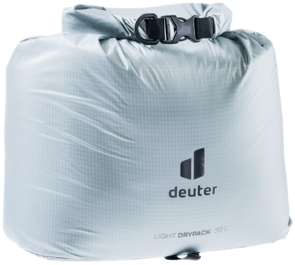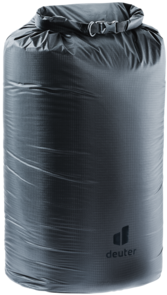OUR PRODUCTS FOR THE WET SEASON

OUR PRODUCTS FOR THE WET SEASON
WHY OUTDOOR SPORTS ARE FUN EVEN IN THE RAIN WITH OUR WATERPROOF PRODUCTS!
Cold, wet, windy: outdoor sports in bad weather place increased demands on equipment. In addition to high-quality clothing and shoes, which should offer both the right weather protection and good breathability, backpacks must also be able to withstand the adverse weather conditions during outdoor activities. Only then can exercise on cold, grey and wet days be fun and ensure physical and mental well-being. Here you can find out why our backpacks and bags can withstand even the most adverse conditions and find the right products for the individual requirements of your outdoor adventures.
WHEN DO WE USE WATERPROOF MATERIALS?

WHEN DO WE USE WATERPROOF MATERIALS?
In the interest of the consumer (price) and nature (treatment and choice of materials), we only use waterproof materials and special constructions where their use really makes sense. These are, on the one hand, rain covers and dry bags, but also bicycle rear panniers and mountaineering backpacks, which are extremely exposed to rain showers, melting and splashing water.
WHAT DISTINGUISHES OUR WATERPROOF PRODUCTS AND HOW DO WE TEST THEM?
To make exactly these products reliably waterproof, we have considered the following:
- durable material with 10,000 mm water column
- taped seams, sealed waterproof by hot pressing
- TPU coated zippers
We tested the fact that this reliably protects the contents of the bag against water when used for its intended purpose under almost real conditions: In a ten-meter-high rain tower, bad weather conditions were simulated for two hours and a maximum amount of water was allowed to rain down from above. In figures: a downpour of 450 l/m²/h. In addition, rain was simulated from all sides by using different nozzles. The result: our backpacks and bags reliably defy the most adverse conditions.
HOW IS THE PROTECTION AGAINST WATER PENETRATION CLASSIFIED?
The IP protection class (International Protection - sometimes also Ingress Protection) is an internationally recognised classification standard that indicates the degree of protection against the ingress of moisture/water and dust/foreign bodies. The IP protection class consists of the IP designation and two digits:
- The first digit (0-6) represents the protection against ingress of solid particles such as dust. Thus, this can range from "no protection" (IP0X) to "complete protection against contact and complete protection against dust ingress (dust-tight)" (IP6X).
- The second digit (0-9) stands for protection against ingress of liquids such as water. The protection here ranges from "no protection" (IPX0) to "protected against water during high-pressure/steam jet cleaning" (IPX9).
- If protection against foreign bodies/contact or against water is not required for products, the digit not used is replaced by an X.
no protection
Protection against vertically falling dripping water
Protection against dripping water falling at an angle (up to 15°)
Protection against water spray up to 60° from vertical
Protection against splashing water on all sides
Protection against water jets (nozzle) from any angle
Protection against strong jets of water
Protection against temporary immersion
Protection against permanent immersion
Protection against water during high pressure/steam jet cleaning
WHAT TYPE OF PROTECTION DO OUR WATERPROOF PRODUCTS HAVE?
The waterproofness of our products is based on their intended use. The following products have been classified as IPX2 waterproof:
And the following products or product series as waterproof IPX4:
- Weybridge 20+5
- Weybridge 25+5
- Mainhattan
- Amager
- Cabezon HB
- Cabezon SB
- Durascent 28 SL
- Durascent 30
- Durascent 42+10 SL
- Durascent 44+10
- Vertrail
In addition, all our rain and flight covers are of course made of reliably waterproof material.
Vertrail
The Vertrail is the waterproof (IPX4) backpack for all alpinists who like to move quickly and easily in versatile terrain, whatever the weather. That's why the multifunctional backpack not only sits compactly on the body thanks to the waistcoat carry system, but also protects the bag's contents safely from the penetration of moisture in the event of rain or splashing water thanks to the hard-wearing material, the taped, hot-pressed seams, the TPU-coated zips and the innovative lid construction.
PLAMORT
Plamort is our lightweight bike backpack for rainy days with a very good weight-to-comfort ratio. Its air-permeable Airstripes back system guarantees optimal ventilation and sits compactly on the back even on sporty trails thanks to ergonomic shoulder straps, chest strap and mesh hip fins. Durable material, taped, hot-press sealed seams and TPU coated zips reliably protect the contents of the Plamort from rain or splashing water. Thanks to the practical 2-way zipper construction for easy and quick handling, the Plamort made of waterproof material does not reach the IPXX class of a waterproof product, but is in no way inferior to them - unless you want to take a shower with it.
HOW DO MATERIALS BECOME WEATHER-RESISTANT AND WATERPROOF?
We additionally coat the material of our products on the inside and in the floor area with a PU coating. This is a protective layer of polyurethane. The PU in liquid form is a durable impregnating agent that is sprayed on as a thin film and has strong water-resistant properties. The layer can be applied easily and repeatedly (especially in the bottom area of backpacks) to the entire textile surface or to individual fibres. The PU coating also provides additional robustness, making textiles more tear-resistant and abrasion-proof.
In contrast to a conventional impregnation or a DWR, a PU coating gives the fabric a permanent impermeability. However, after a certain time the softeners dissolve and the PU coating becomes leaky. Here, however, we are talking about periods of time that even our products designed for durability will not "experience".
 Per- and polyfluorinated chemicals, PFAS for short, are substances that are harmful to the environment and health and have been the preferred choice for impregnating textiles due to their previously almost unrivalled water-, dirt- and grease-resistant properties. Due to its widespread use, PFAS has left traces all over the world - in drinking water, breast milk, the air and reproduction. The harmful fluorocarbons also degrade very slowly or not at all. A time bomb for humans, animals and nature. In the meantime, there are environmentally friendly alternatives. With the DWR (Durable Water Repellancy) impregnation, we have completely dispensed with PFAS since 2019 and can still guarantee the high-performance water and dirt-resistant properties of all our products. The environmentally friendly surface treatment, which is harmless to health, takes us one step further on our path of responsible and sustainable action.
Per- and polyfluorinated chemicals, PFAS for short, are substances that are harmful to the environment and health and have been the preferred choice for impregnating textiles due to their previously almost unrivalled water-, dirt- and grease-resistant properties. Due to its widespread use, PFAS has left traces all over the world - in drinking water, breast milk, the air and reproduction. The harmful fluorocarbons also degrade very slowly or not at all. A time bomb for humans, animals and nature. In the meantime, there are environmentally friendly alternatives. With the DWR (Durable Water Repellancy) impregnation, we have completely dispensed with PFAS since 2019 and can still guarantee the high-performance water and dirt-resistant properties of all our products. The environmentally friendly surface treatment, which is harmless to health, takes us one step further on our path of responsible and sustainable action.
We also take care in the construction of our backpacks that little moisture can penetrate into the inside of the backpack through openings or other product features. For example, a drawstring under the lid compartment (snow skirt, spindrift collar) keeps the moisture out if the lid compartment of the backpack should ever slip.
WHAT IS BEHIND THE CHARACTERISTICS WEATHER-Resistant, WATER-REPELLENT, WATER-RESISTANT OR WATERPROOF?
A product that is designated as weatherproof can withstand wind, rain and sun. This is measured by the following standards:
The wind resistance of the fabric is measured using the wind flow measurement (CFM). It expresses how easily air (usually at a speed of 48 km/h) can flow through a fabric. The lower the rating number, the more wind-repellent the fabric. This means < 1 cfm repels the most wind and is therefore 100 % windproof. The more "hard-shelled" or dense the fabric, the less wind will normally penetrate it.
To measure the rainproofness of a material, a water pressure test is used to see if water leaks through the material. Here, the force of wind-driven rain is the benchmark. It is 2 psi. Fabrics with at least 3 psi are therefore considered weatherproof.
The UV protection factor or UPF indicates how many UV rays can penetrate a fabric. The lower the rating, the less UV resistant the product. A UV protection rating of 30 is typical for sun-resistant fabrics and blocks almost 97% of UV rays. 50+ offers the maximum protection. The tighter or heavier the fabric or the darker the colour, the better the protection.
That doesn't sound crazy at first. But if we look at the whole thing with a temporal component, then continuous weather influences can cause strong signs of wear on the material.
If this does not happen, i.e. if routine weather influences do not affect the material and it remains in a "like new" condition even after a long time, then we speak of weatherproof - and in terms of protection against moisture: waterproof.
The demands on the material of weather-resistant products are high. And ours is even higher. Because in addition to the essential characteristics such as robust, waterproof and durable, we are increasingly trying to use sustainable materials certified according to official environmental standards for our backpacks. In addition, we also try to offer the best possible weather protection for the seams, pocket openings and zips, as these are always weak points in terms of weather resistance.
If water-repellent products are either made of fabrics that are so tightly woven per se that it is difficult for water to penetrate them, or if they are made of materials such as polyester or nylon that are more resistant to water due to their structure alone, or if they are specially treated with an additional coating or impregnation, the material becomes water-resistant. Water-resistant materials offer greater protection in wet conditions than waterproof ones. This means that water beads off the surface and cannot penetrate the material as easily. The technical term for this is "hydrophobic". However, in continuous or heavy rain as well as high pressure on the material, it cannot be ruled out that wetness will penetrate the inside at some point.
As a backpack manufacturer, we use tightly woven and thus waterproof fabrics for our products. In order to increase the water repellence of the material and thus make it water-resistant, we have exclusively used a DWR (Durable Water Repellency) impregnation since 2020. This means that we do not use PFAS at all and still ensure the high-performance water- and dirt-repellent properties of all our products. In addition, we provide the inside of the material with a durable PU coating.
Due to high water pressure (e.g. heavy rain) or additional high pressure on the material (e.g. bulging backpack), moisture can penetrate through the coating and the material into the interior. To prevent this, waterproof material is used for particularly extreme weather conditions.
Whether the material used can be defined as water-resistant or waterproof is decided on the basis of the definition used by the textile industry based on international standards for waterproofness. The hydrostatic water column is a unit of measurement that indicates the water pressure that the material can withstand before the water penetrates. For outdoor products, it is the load limit above which a textile becomes water-permeable. The pressure is given in millimetres. Thus, 1 bar corresponds to about 10,000 mm water column.
Generally speaking, the higher the value, the denser the material. But what do we really need? The European standard DIN EN 343:2010-05 (protective clothing against rain) defines a water entry pressure of 800 mm as the lowest limit. From here on, one speaks of waterproof. Everything below this is declared water-resistant.
Depending on the load, duration and intended use to which the material is exposed, higher values are certainly required. For example, a person weighing 80 kg exerts a pressure of 1,000 mm when lying down, 5,000 mm when sitting and 14,000 mm when kneeling. The material must withstand this pressure and prevent the water from penetrating over a longer period of time. A good guideline for the waterproofness of outdoor clothing is 10,000 mm.
However, a waterproof material does not necessarily mean that the product is waterproof. The entire construction, including potential water entry points such as closures, seams, pockets and openings, must be sealed or even welded waterproof and must be able to withstand stresses such as use and care (washing, drying or mechanical stresses) over the long term. Because the state of use of the product also has an influence on the waterproofness. Therefore, proper care and cleaning are really crucial for the performance of the product.
LIFETIME REPAIR SERVICE
Should your deuter product ever get into trouble and urgently need a repair that you can't carry out yourself, we will be very happy to help you.




































































